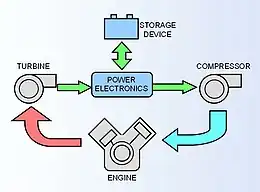Electrically assisted turbocharger
An electrically assisted turbocharger (EAT) is an arrangement where an electric motor assists the gas-driven turbocharger in providing forced induction, particular at times when exhaust gas flow is insufficient to produce the desired boost.[1] Some systems integrate the motor inside a turbocharger, while others use a separate electric supercharger.

Systems
BorgWarner
BorgWarner tested the idea in the 1990s, but never produced a part for production vehicles because of high power consumption, until the Mercedes-Benz M256 engine (2017), which used a 48-volt electrical system.[2]
As of January 2023, BorgWarner markets two EAT solutions: a standalone "electric compressor" (i.e. supercharger) named eBooster and a turbocharger with a single-shaft motor attached named eTurbo.[3]
Garrett Motion
In October 2019, Garrett Motion announced its first electric turbocharger for market passenger vehicles, with expected launch in 2021.[4] The design adds an electric motor between the turbocharger's turbine wheel and compressor wheel.
The 2023 Mercedes-AMG SL 43 convertible uses the Mercedes-Benz M139 engine, which features the integrated Garrett Motio EAT.[5]
Volkswagen TDI
The TDI line used by the Audi brand has seen 4.0 V8 TDI 310-320kW, used on the Audi SQ7 and more. It has 2 turbochargers and 1 electric supercharger.[6]
Volvo
In 2010, Volvo started to experiment with electrically assisted turbochargers. The result was unveiled in 2014, a 450hp 2.0L High Performance Drive-E Powertrain Concept engine, which used a 48-volt electrical system for the electric booster. The engine has three turbos, with the electric "turbo" driving the exhaust turbines of the twin-turbo.[7] Despite initial reports that the Volvo XC90 T6 would have an related improvement,[8] only the 2016 Volvo XC90 T8 actually received a Twin Engine starter-generator-supercharger in addition to the mechanical twincharger arrangement.[9]
In 2019, Volvo reiterated plans to replace the mechanical supercharger with an electric one.[10]
Abandoned
In the late 1990s, Turbodyne also investigated EAT designs.[11]
Related devices
An electric supercharger also uses an electric motor to power the compressor, however the electric motor is the sole power source in an electric supercharger.
A turbocharger that can divert some of the exhaust gas to produce electricity (using the vehicle's alternator) is sometimes called a hybrid turbocharger.[12]
References
- "Electric Boost". www.autospeed.com. Retrieved 20 June 2022.
- "A Little Fan That Fixes the Turbocharger's Biggest Problem".
- "Electric Boosting Technologies". BorgWarner.
- "Garrett To Launch Industry's First Electric Turbo".
- "Nerd's Eye View: Mercedes AMG M139 Engine with E-turbo and Liquid Immersion Battery Cooling". MotoIQ. 11 April 2021.
- V8-Diesel im Audi SQ7: Zukunft, Konkurrenz - Fette Acht statt sechs in Reihe
- "Volvo's Drive-E Engine Family Adds Triple-Boosted 4 Cylinder Concept". EngineLabs. 7 October 2014.
- "Volvo Bets Its Future on Small, Turbocharged Engines".
The 2016 XC90 (on sale early next year) is the first of this new generation of Volvos. It's powered by a 2.0-liter four-cylinder engine with a turbocharger and a supercharger.
- "Volvo Cars introduces Twin Engine technology in world's most powerful and cleanest SUV". www.media.volvocars.com (Press release). Volvo Car Corporation. 8 December 2014. Archived from the original on 2017-11-07.
- "Volvo to Start Using Electric Superchargers". Car and Driver. 17 May 2019.
- "AlliedSignal and Turbodyne to Jointly Develop Mass Production Capabilities". www.theautochannel.com. Retrieved 20 June 2022.
- "Hybrid Turbocharger, Ship Marine Engine Turbocharger, High Speed Motor for Marine Applications, Marine Power Generation, High Speed Generator, Marine Engine Heat Recovery". www.calnetix.com. Retrieved 20 June 2022.